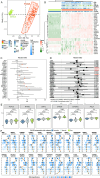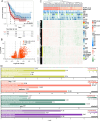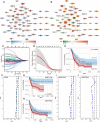Integrative multi-omic analysis of NLRP3 inflammasome dysregulation and subtyping for personalized treatment in acute myeloid leukemia
- PMID: 40593281
- PMCID: PMC12214187
- DOI: 10.1007/s12672-025-02383-9
Integrative multi-omic analysis of NLRP3 inflammasome dysregulation and subtyping for personalized treatment in acute myeloid leukemia
Abstract
Acute myeloid leukemia (AML) is a devastating form of blood cancer characterized by uncontrolled growth and impaired maturation of myeloid precursor cells in the bone marrow. Despite advancements in treatment strategies, the prognosis for AML patients remains poor. The NLRP3 inflammasome, a multi-protein complex involved in innate immunity and inflammation, has been implicated in various diseases; however, its role in AML development and progression is not well understood. In this study, we analyzed genomic, bulk-, and single-cell transcriptomic data to assess the contribution of NLRP3 inflammasome genes to AML. Results suggested that 28 NLRP3 inflammasome genes with clinical implications were dysregulated in AML. Notably, we identified seven prognosis-related genes: CASP1, CPTP, MEFV, NFKB2, PANX1, PYCARD, and SIRT2. To further investigate the functional relevance of NLRP3 inflammasome genes, we developed an NLRP3 score (Nscore) based on the expression levels of these seven genes. We identified four dysregulated gene clusters that distinguished high- and low-Nscore groups, enabling the identification of two distinct AML subtypes, with subtype 2 exhibiting worse overall survival than subtype 1. Additionally, using a network-based approach, we identified 62 NLRP3 inflammasome-related genes and constructed a risk score model with COL2A1, ITGB2, and SRC genes, providing a comprehensive assessment of patient risk stratification. We revealed a positive correlation between the Nscore and macrophage M1, suggesting potential drug response mechanisms. Based on the identified AML subtypes and their distinct mutational landscapes, we predicted potential treatment options, with Paclitaxel, Afuresertib, and Mitoxantrone emerging as potential therapeutic agents for the AML subtypes.
Keywords: Acute myeloid leukemia; Drug response; NLRP3 inflammasome; Prognosis; Tumor immune microenvironment.
© 2025. The Author(s).
Conflict of interest statement
Declarations. Competing interests: The authors declare no competing interests.
Figures






Similar articles
-
Systemic pharmacological treatments for chronic plaque psoriasis: a network meta-analysis.Cochrane Database Syst Rev. 2021 Apr 19;4(4):CD011535. doi: 10.1002/14651858.CD011535.pub4. Cochrane Database Syst Rev. 2021. Update in: Cochrane Database Syst Rev. 2022 May 23;5:CD011535. doi: 10.1002/14651858.CD011535.pub5. PMID: 33871055 Free PMC article. Updated.
-
The joint role of the immune microenvironment and N7-methylguanosine for prognosis prediction and targeted therapy in acute myeloid leukemia.Front Genet. 2025 Jun 13;16:1540992. doi: 10.3389/fgene.2025.1540992. eCollection 2025. Front Genet. 2025. PMID: 40584831 Free PMC article.
-
Thrombopoietin mimetics for patients with myelodysplastic syndromes.Cochrane Database Syst Rev. 2017 Sep 30;9(9):CD009883. doi: 10.1002/14651858.CD009883.pub2. Cochrane Database Syst Rev. 2017. PMID: 28962071 Free PMC article.
-
Systemic pharmacological treatments for chronic plaque psoriasis: a network meta-analysis.Cochrane Database Syst Rev. 2017 Dec 22;12(12):CD011535. doi: 10.1002/14651858.CD011535.pub2. Cochrane Database Syst Rev. 2017. Update in: Cochrane Database Syst Rev. 2020 Jan 9;1:CD011535. doi: 10.1002/14651858.CD011535.pub3. PMID: 29271481 Free PMC article. Updated.
-
A systematic overview of chemotherapy effects in acute myeloid leukaemia.Acta Oncol. 2001;40(2-3):231-52. doi: 10.1080/02841860151116321. Acta Oncol. 2001. PMID: 11441935
References
-
- Shimony S, Stahl M, Stone RM. Acute myeloid leukemia: 2023 update on diagnosis, risk-stratification, and management. Am J Hematol. 2023;98:502–26. 10.1002/ajh.26822. - PubMed
-
- Dohner H, Wei AH, Appelbaum FR, Craddock C, DiNardo CD, Dombret H, et al. Diagnosis and management of AML in adults: 2022 recommendations from an international expert panel on behalf of the ELN. Blood. 2022;140:1345–77. 10.1182/blood.2022016867. - PubMed
LinkOut - more resources
Full Text Sources
Miscellaneous
